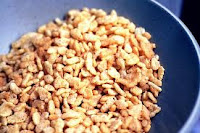Tips for Eating Healthy When You’re Away From Home
You probably already know that Americans need to eat more whole grains, low-fat milk, and fruits and vegetables. What you might not realize is that Americans tend to make poorer choices when eating away from home. For example, eating breakfast away from home usually means eating fewer whole-grains and dairy foods and more calories from saturated fat and added sugar. When people eat their dinner away from home they tend to eat fewer vegetables, especially the nutritious vegetables in the dark green and orange category.

The tendency to make poorer choices when eating out is increasingly important because the average American now spends two of every five food dollars on food that is eaten away from home. Unless you make careful choices, eating just one meal away from home each week can add enough extra calories to your diet to produce a gain of two pounds per year.
Eating out doesn’t have to mean eating poorly. Keep the following tips in mind when eating at a restaurant or fast food place:
--To reduce the calories and fat in your meal, cut back on fried foods; order meat, chicken, and other items that are roasted, grilled, baked or broiled.
--Drink fat-free or low-fat milk, water or coffee instead of sugary drinks like soda.
--Look for places that offer whole-wheat bread or buns as an option for sandwiches or subs.
--Make sure there’s at least one vegetable (other than potatoes) in your entrée or side dish. For example, order pasta with plenty of tomato sauce and added vegetables like green peppers or broccoli.
--Keep the fat and calories lower by ordering dishes that are steamed, grilled or broiled instead of fried and looking for sauces based on tomatoes or broth instead of creamy sauces and gravies.
--Be on the lookout for menu items that have high-fat ingredients like mayonnaise, full-fat salad dressing, and bacon.
--If the regular portion sizes are large, order an appetizer for your main dish or share the regular main dish with a friend.
--Check the establishment’s nutrition handouts or website postings for key nutrition information like calories, sugar, and sodium in the dishes you tend to order most often.
Source: Susan Nitzke, University of Wisconsin-Extension Nutrition Specialist and Professor Emeria, University of Wisconsin-Madison
















